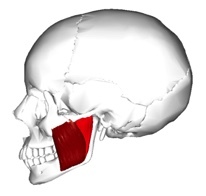Our Fall theme is TLC for the TMJ!
 Our jaw is the TemporoMandibular Joint -TMJ for short. The TMJ forms a hinge (one on each side of the face). This hinge allows for absolutely essential activities: talking, eating, and drinking! Because we use the TMJ all the time, it can be prone to wear, tear, and abuse. Even at “rest” many of us unconsciously clench our jaw muscles, creating pressure on the small TM joints and on the teeth. Dentists will attest to growing numbers of people wearing down their teeth enamel from grinding and clenching their jaws, often in their sleep. Mouth guards can prevent enamel damage but they won’t prevent the clenching from occurring.
Our jaw is the TemporoMandibular Joint -TMJ for short. The TMJ forms a hinge (one on each side of the face). This hinge allows for absolutely essential activities: talking, eating, and drinking! Because we use the TMJ all the time, it can be prone to wear, tear, and abuse. Even at “rest” many of us unconsciously clench our jaw muscles, creating pressure on the small TM joints and on the teeth. Dentists will attest to growing numbers of people wearing down their teeth enamel from grinding and clenching their jaws, often in their sleep. Mouth guards can prevent enamel damage but they won’t prevent the clenching from occurring.
TMJ dysfunction can result in persistent headaches, reduced jaw range of motion, clicking and popping sounds with chewing, tooth damage, and ear aches. Due to its proximity to the ear canal, TMJ dysfunction can even create symptoms affecting balance or feelings of vertigo.
A TMJ Self Test:
The “3 finger test” isn’t a diagnosis, but it can give you a sense of your general TMJ range of motion. Can you fit the width of three fingers in your open mouth (see picture)? If not, this could be a significant sign of a potential issue with the TMJ.
Massage therapy can be a big help!
Registered Massage Therapists are trained in treatment techniques for this crucial part of the body. Through a variety of massage techniques and gentle joint manipulations, pain and stiffness can be reduced. Symptoms of dysfunction such as headaches, clenching, clicking and popping can be greatly eased through massage therapy, stretching, and self-care.
Here is one soothing self-care technique to promote jaw relaxation before bed. This comes from John Corry, a top TMJ therapist and teacher in Canada:
Epsom Salts Compress: Before Bedtime
- Pour 1.5 cups of Epsom salts into a bathroom sink of hot water.
- Immerse 2 face cloths to absorb salts.
- Wring out and apply to each cheek until the heat is neutralized, repeat.
Aimée is training with John Corry to learn specialized TMJ treatment techniques. The TMJ treatment often includes muscle relaxation work to the shoulders, neck, and to the muscles of the jaw. These techniques can also include intra-oral techniques (in the mouth) to target hard-to-reach muscles with a gloved finger. If you’re interested in learning more, or in incorporating TMJ treatment to your massage therapy treatment, please contact Aimée at Therapy Lounge for more information, or book your TMJ treatment with her starting in October.





Comments are closed.